|
DLI 8300 Rugged Tablet
A rugged, compact multi-purpose tablet computer for tough jobs in the field and on the road
(by Conrad H. Blickenstorfer, with photography by Carol Cotton)
Laporte, Indiana based DLI was founded in the early 1990s as a manufacturer and reseller of wireless data collection devices. They carry mobile computers, vehicle mounted terminals, handhelds, rugged ultra-mobile tablets, and rugged yet compact general purpose tablet computers like the DLI 8300 examined in this report.
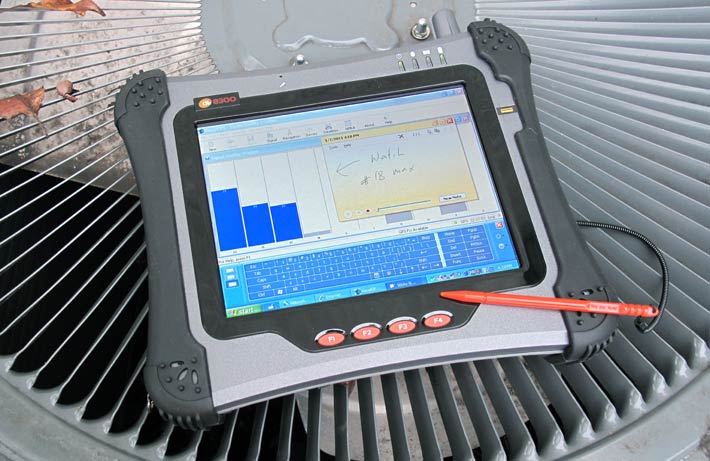
While ruggedized tablet computers have been around for quite some time, DLI was somewhat of a pioneer with the attractively designed DLI 8300 rugged tablet, switching to the Intel Atom processor architecture back in December of 2008 when most of the competition was still using older processor families. The 8300 itself originally came with an AMD Geode LX 800 chip, but DLI early on saw the potential of the Atom architecture and made the switch.
The DLI 8300 is a fairly compact (10 x 8.5 inches, excluding the antenna and bumpers) and elegantly designed rugged tablet computer that can be used as a vehicle mount or mobile system. Depending on the application, the device can be configured with Windows 7, Windows XP Pro or the XP Tablet PC Edition, Windows Embedded Standard, or Linux. The DLI 8300 is equipped with either up to 64GB of SSD Flash or a 60/80 GB shockmounted hard disk. The thick rubber protection on each side can quickly be removed for use in vehicles or whenever it's not needed.
Intended uses include field service, mobile payments, first responders, fleet management, and any other application that can benefit from a compact, rugged, ergonomically designed, and highly configurable tablet computer. Despite its rather compact size, the DLI 8300 offers very good battery life, exellent security, and a variety of data collection options.
Our review unit came with a resistive touchscreen for indoor/outdoor viewing (a digitizer is available) and ran the Windows XP Tablet PC Edition. The 8.4-inch display has a strong 400 nit backlight and offers native 800 x 600 pixel SVGA resolution (1024 x 768 is possible, too, but it's not as crisp). There are two USB 2.0 ports, Ethernet, a biometric reader, and two pass-through connector to a cradle. Optionally available are either an integrated Honeywell Adaptus Imager or Motorola Lorax scanner; an integrated 3-in-1 module with mini magstripe reader, RFID, and imager; Class 2 Bluetooth; and various WWAN radios supported by Verizon, AT&T, Sprint, and T-Mobile.
The concept of a tablet like the DLI 8300
This review was published just after the conclusion of the 2011 Consumer Electronics Show in Las Vegas. The show had been highly anticipated in part because the industry was expected to present viable competition to Apple's iPad tablet that had sold well over ten million in 2010. Some interesting tablet products were presented, but overall more questions were raised than answered. For example, it remained unclear whether the primary competition to the sleek Apple tablet that completely redefined user expectations would come from Microsoft-based tablets or systems that use the rival Android platform that initially began as a smartphone OS.
It is important to realize that those iPad-style tablets are fundamentally different from the DLI 8300. The iPad is primarily designed to be a browser of information, whereas tablets such as the 8300 were designed to bring the full power of Microsoft Windows into the field. So when examining the DLI 8300, it should not be compared to a consumer device such as the iPad, but to how it compares to existing tablet computers for commercial and industrial markets. DLI itself offers a variety of tablets in various sizes and designs, each emphasizing certain strengths and features.
Unlike its DLI 8400 sibling (see our full review of the DLI 8400 here) that incorporates a thumb-type keyboard, the DLI 8300 is a true tablet and all input is via stylus, touch, onscreen keyboard or the four hardware function buttons (you can connect an external keyboard, which is useful when the tablet is in its dock). Note, though, that DLI equips this tablet with a resistive digitizer that's best used with a stylus, as opposed to using projected capacitive touch technology popularized by Apple with the iPad. Also note that there is no navigation diamond or touchpad as is sometimes found in this class of device. And unlike the DLI 8400 UMPC and the smaller DLI 8800 tablet (see review here), the 8300's fairly large 8.4-inch display uses the older 4:3 aspect ratio.
As all of DLI's products, the 8300 merges style, elegance and ergonomics with industrial quality materials, manufacturing and attention to detail. The housing consists of a matte-gray ABS+PC polymer that's extremely tough, highly resistant to impact, and not easily scratched. Like the entire DLI lineup, the 8300 features design that is simple yet elegant and purposeful, and it's instantly obvious that the machine is built to last. DLI does not use chrome, trim or exposed metal here. The only glossy element of the design is a shiny black bezel surrounding the matte LCD display and encompassing the function buttons below the screen. A rubberized band goes around the entire unit and the four corners are protected by thick and easily replaceable/removable rubber bumpers that give the unit a tough and businesslike appearance.
Looking at all sides of the DLI 8300
The composite picture below shows the DLI 8300 from the front and all four sides. Again, note that the thick rubber bumper can easily be removed, providing protection when needed. You can also see that all ports are mostly placed along the bottom of the unit.

Here's what the DLI 8300 offers:
- 2 standard-size USB 2.0 ports
- A RJ45 LAN jack
- Two RF pass-throughs
- Two docking connectors.
All of those ports are IP67 rated (i.e. water and dust-proof) and can be used with sealed locking connectors.
On top of the unit is the window of the optional integrated JPOS-compliant Adaptus imager and the antenna nob.
Both the left and right side have two metal D-rings each. They can be used to attach a carry or shoulder strap in any position. Each side also has a programmable scanner button.
Unlike the DLI 8400 ultra-rugged UMPC, the 8300 has no externally accessible card slots (there are slots underneath a cover).
The two pictures below show the 8300 from the back with the protective rubber bumpers removed. On the left side is the unit with its external battery and expansion bay cover removed. The tethered orange stylus can be parked inside a garage on top of the yellow label.
The picture to the right shows our review unit with its external battery sitting loose on the backside. The battery has a springloaded lever that must be pushed to unlock it.
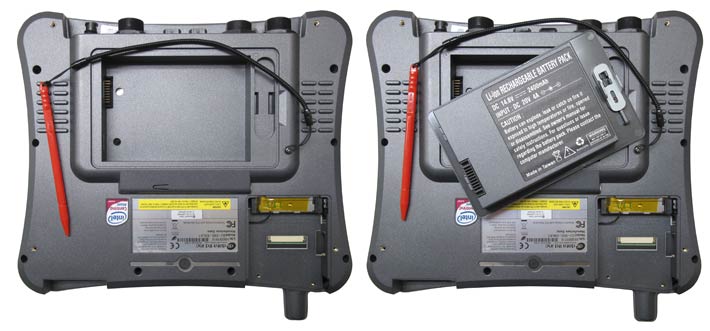
Desktop/vehicle cradle: secure mounting, easy transition, and additional ports
While rugged tablet computers such as the DLI 8300 are designed to be carried around and used on the job, most will also be used in offices or mounted in vehicles. This means that you need a good dock/cradle. Our evaluation unit came with the optional vehicle mounting cradle that makes transitioning in and out of the vehicle easy while maintaining full wireless communications functionality. The cradle has a spring-loadable locking mechanism that can be released by pushing the button with the DLI logo in the front. A simple pad lock can be used to secure the unit. The dock has a configurable port replicator. Our dock had three DB9 RS232 serial ports, three USB 2.0 ports, a 10/100 RJ45 Ethernet port, and external cellular and GPS antenna passive connections. Also available are J1708/J1939 and/or CANbus vehicle bus connectors, as well as a 10-60 Volt DC integrated power regulating converter.
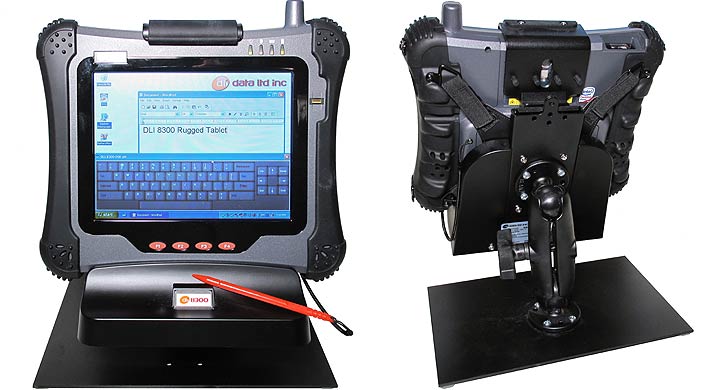
 The images above show our review unit securely positioned into the vehicle cradle. There is a standard VESA mount that can be used with RAM Mounts' patented clamp mounts. The images above show our review unit securely positioned into the vehicle cradle. There is a standard VESA mount that can be used with RAM Mounts' patented clamp mounts.
RAM Mounts has a wide variety of vehicle mounting systems, with all sorts of arms, connectors, extensions and whatever you need to securely, yet flexibly, mount a mobile computer. Their universal ball-and-socket system holds any amount of weight in high vibration applications for military, commercial and private use, making it an ideal solution for mobile applications.
On the right you can see a picture of the bottom of the vehicle dock. Ports are as described above. USB and LAN jacks use screw-mount sealed connectors, and you can see the available cut-outs for additional connectivity.
Overall, this is a compact, lean, well-made dock that gets the job done.
Ruggedness
The difference between a consumer market tablet such as the Apple iPad and a vertical market tablet such as the DLI 8300 is not so much quality (the iPad is very well made) as it is design goals. iPads are expected to be babied and the emphasis is on sleek design and lowest possible weight. Vertical market tablets, on the other hand, are designed and built to handle the abuse they are likely to encounter while on the job. That includes rough handling, getting dropped, getting rained on, and being used in a wide range of temperatures.
DLI addressed those requirements by giving the 8300 the ability to survive multiple four-foot drops to bare concrete, a very wide operating temperature range of -4 to 140 degrees Fahrenheit, the ability to withstand fairly severe vibration, and IP54 sealing against dust and liquids. What does that mean on the job?
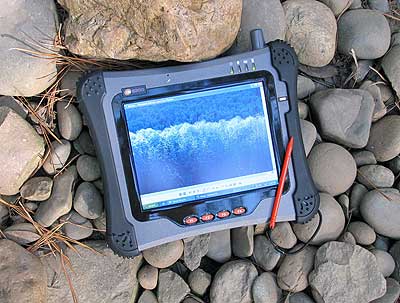 A four-foot drop to a hard surface means that the device won't be destroyed if it slips out of your hands while you carry it around or are working on it. The DLI 8300's thick rubber bumpers (though not as exaggerated as on its DLI 8400 sibling) provide additional protection and also reduce the likelihood that surfaces get scratched. Shock protection is less for the 8300 than the 8400 with its massive bumpers (20G operating for 11ms vs 40G). A four-foot drop to a hard surface means that the device won't be destroyed if it slips out of your hands while you carry it around or are working on it. The DLI 8300's thick rubber bumpers (though not as exaggerated as on its DLI 8400 sibling) provide additional protection and also reduce the likelihood that surfaces get scratched. Shock protection is less for the 8300 than the 8400 with its massive bumpers (20G operating for 11ms vs 40G).
The -4 to 140 degree Fahrenheit operating range covers just about any conceivable application, from freezers and arctic climates all the way to deployment in deserts.
The device carries an IP54 ingress protection rating, where the "5" means the unit is protected against dust (though small, non-harmful deposits are allowed under this classification), and the "4" means it's protected against water sprayed from all directions, again with limited ingress permitted. This means the 8300 can handle operation in moderately dusty environments and it can handle a bit of occsional rain. DLI could probably easily make the device IP65 compliant as the ports -- usually the weak links -- are already properly sealed. As is, however, we wouldn't push it as there are no O-ring seals in the battery compartment or expansion bay.
At least on our review unit the large rubber bumpers were fitted very loosely, attached by just two small screws each. They could easily catch on something or even get ripped off. They should either be attached with additional screws, or glued on.
For the DLI 8400, the company specifically listed MIL-STD-810F testing in various categories. DLI 8300 specs include fewer ruggedness categories, so if things like salt fog resistance or high altitude operation are required, consult with DLI.
Powered by Intel Atom
Like almost all compact tablets released over the past two years or so, the DLI 8300 is based on Intel's Atom processor architecture that was introduced as an optimized solution for devices that did not require Intel Core processor performance or simply needed a processor solution that generated less heat and used less battery power. While vertical market manufacturers were initially skeptical about the platform's ability to provide acceptable performance, Atom processors became hugely popular with tens of millions of Atom-powered netbooks sold. As a result, a growing number of vertical and embedded market vendors adopted Atom as well, and today Intel offers an almost dizzying variety of Atom chips. Let's take a quick look at Atom's background.
Facing growing criticism over its very average mobile processor offerings, Intel charged ahead with its Core 2 Duo and later Core i3/i5/i7 processor lines, but those are are costly and not very power efficient. So the Atom line was designed for low power consumption and low cost while still delivering adequate (or, as is often used, "targeted") performance. To achieve that, the Atom platform was an entirely new design that allowed Atom chips to require much less power than even the slowed-down ultra-low voltage mobile versions of Intel's Core processors. There is the inevitable trade-off, of course. In order to preserve power and keep costs down, most Atom chips only have one core and must do without many of Intel's more advanced technologies.
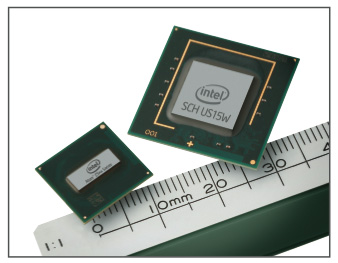 As is, Atom processor architecture is fairly simple but includes a wealth of power conservation features. A special bus mode minimizes power needed to transmit data to the processor. During periods of inactivity, cache is flushing cache data to system memory. Other Intel power conservation modes were improved and a new standby mode can essentially shut down the processor. Combined, these measures can result in greatly reduced overall power consumption while still providing acceptable performance. As is, Atom processor architecture is fairly simple but includes a wealth of power conservation features. A special bus mode minimizes power needed to transmit data to the processor. During periods of inactivity, cache is flushing cache data to system memory. Other Intel power conservation modes were improved and a new standby mode can essentially shut down the processor. Combined, these measures can result in greatly reduced overall power consumption while still providing acceptable performance.
The Z530 processor used in the DLI 8300 is part of the original Z5xx family of Atom processors, codenamed "Silverthorne" (see Intel brochure on the Z5xx). DLI chose the original 13 x 14 mm package version as opposed to the "large footprint" "P" version with a 22 x 22 mm package size. Intel targeted the Silverthorne chips at mobile internet devices (MIDs), but they have also become quite common in rugged mobile and embedded devices. The Silverthorne processors use the "Poulsbo" System Controller Hub that was developed specifically for the Z5xx Series. The chipset—which supports PCI-E, SDIO, DDR2, LVDS, ATA 100, LPC and more—uses only about 2.3 watts, which means the total power consumption of the CPU and chipset combined isn't even 5 watts. That is only a small fraction of what a conventional Intel notebook processor and chipset uses. And the Poulsbo chipset even has hardware support for H.264 and other HD decoding (see Intel brochure on the "Poulsbo" US15W SCH).
Note that by now Intel is offering several dozens of different single and dual core Atom chips and chip families (the D and E series have been added to the original Z and N series) targeted at different devices and operating at different clock speeds. However, the 1.6GHz Z530 used in the DLI 8300 is far and away the most popular chip in Atom-powered vertical market devices and it likely won't go away anytime soon.
Clever dual battery system
One of the primary selling points of Intel's Atom chips is their low power consumption. That generally goes hand in hand with low heat generation, both good qualities to have in a mobile device. The Z530 processor has a maximum thermal design power of just over two watts, compared to many times that number even in low voltage Intel Core i5 or i7 processors. How well does the DLI 8300 take advantage of its frugal chipset, and does low power consumption turn into long battery life?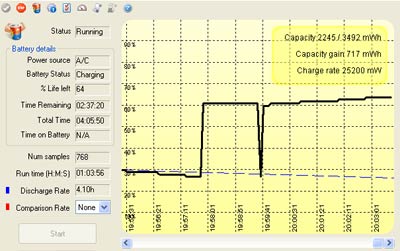
One of the cool things about the DLI 8300 is that its battery is hot-swappable. And not only that; the computer keeps running on its backup battery for a good, long time. About two hours, in fact. That's because while most ruggeds do not have an internal battery backup that makes the primary battery hot-swappable, and those that do have such a backup usually only provide a few minutes for swapping, the DLI 8300 has a large second battery inside. The secondary is not externally accessible at all, and there is also no access door, so replacement of the secondary is a maintenance task. DLI specs the external battery as 14.8V/2,600mAH (38.5 watt-hour) but only provides amperage (1,950mAH) for the internal battery, so we're not sure of watt-hours.
The DLI 8300 wasn't totally compatible with our standard power draw benchmark, Passmark's BatteryMon, and so we only got approximate results and BatteryMon suggested battery life between four and five hours, which coincides with DLI's specs. However, based on our experience with similar Atom-powered systems, we'd expect a minimum draw of about 7-8 watts, which would mean that the external battery alone would theoretically be good for at least five hours. So our battery life results are inconclusive.
The picture on the right shows the 8300 first drawing from just its internal backup battery, with the main battery removed. Then you see a sharp increase in remaining battery capacity as the external battery is inserted as well. Then, as we we put the device on charge, it briefly reverted to just the internal battery and then began charging.
Overall, having that substantial second battery inside provides not only much longer battery life, but also peace of mind. Backup batteries often provide so little power that you never know if they'll die before you manage to replace the main battery with a fresh one. That's one problem you never have with the 8300.
Netbook-class performance
The flipside of the Atom processor's efficiency and relative simplicity is that it operates at lower performance levels than Intel's Core processors. Performance is targeted towards certain applications where the chip is "fast enough." That's not a bad approach. Tens of millions of netbooks using Atom processors are fast enough, with users being fully aware that an inexpensive netbook cannot provide the same performance as a much more expensive Core-based computer. Are Atom chips fast enough for vertical market tablets?
Based on our benchmark library of Atom Z530 systems, we expected the DLI 8300 to feel about as fast as a standard consumer netbook and its relative performance compared to most full-size rugged tablets on the market to be at about the 60-65% level. More importantly, we wanted to see how the 8300 performs compared to systems based on the same chip architecture.
We used Passmark Software's PerformanceTest 6.1 that runs about 30 tests covering CPU, 2D graphics, 3D graphics, memory, and disk and then computes scores for each category and an overall PassMark score. For comparison, we're listing RuggedPCReview benchmark results for two other DLI models as well as four other small tablets using the Z-Series Atom processor. Here are the results:
|
PERFORMANCE COMPARISON
|
DLI
|
DLI
|
DLI
|
Logic Instrument
|
Panasonic
|
Handheld
|
Samwell
|
|
Model
|
DLI 8300
|
DLI 8800
|
DLI 8400
|
FieldBook
|
H1 Field
|
Algiz 7
|
SR820
|
|
Processor: Intel
|
Atom Z530
|
Atom Z530
|
Atom Z530
|
Atom Z530P
|
Atom Z540
|
Atom Z530
|
Atom Z530
|
|
CPU Speed
|
1.60 GHz
|
1.60 GHz
|
1.60 GHz
|
1.60GHz
|
1.86Hz
|
1.60GHz
|
1.60Hz
|
|
Thermal Design Power (TDP)
|
2.3 watts
|
2.3 watts
|
2.3 watts
|
2.3 watts
|
2.4 watts
|
2.3 watts
|
2.3 watts
|
|
CPU Mark
|
248.1
|
240.4
|
237.8
|
235.5
|
275.4
|
217.8
|
248.7
|
|
2D Graphics Mark
|
130.9
|
127.4
|
59.5
|
84.6
|
115.7
|
56.7
|
101.8
|
|
Memory Mark
|
224.4
|
116.5
|
209.5
|
224.4
|
242.7
|
208.7
|
222.5
|
|
Disk Mark
|
217.8
|
253.9
|
147.4
|
266.4
|
284.8
|
175.6
|
218.6
|
|
3D Graphics Mark
|
18.0
|
16.6
|
40.3
|
9.8
|
10.1
|
17.7
|
18.6
|
|
Overall PassMark
|
171.4
|
176.3
|
144.6
|
170.3
|
191.9
|
141.6
|
167.4
|
|
ALU
|
5383
|
5485
|
5375
|
5339
|
6149
|
5050
|
5272
|
|
FPU
|
4472
|
4493
|
4068
|
4330
|
5414
|
3629
|
4571
|
|
MEM
|
3848
|
4077
|
4125
|
3706
|
4327
|
4143
|
3969
|
|
HDD
|
3704
|
4510
|
3647
|
5197
|
5156
|
6804
|
3678
|
|
GDI
|
2173
|
2092
|
1722
|
2752
|
1202
|
1866
|
2806
|
|
D2D
|
1075
|
1015
|
893
|
1053
|
187
|
976
|
1048
|
|
OGL
|
375
|
347
|
332
|
344
|
400
|
326
|
346
|
|
Overall CrystalMark
|
21030
|
22019
|
20162
|
22721
|
22835
|
22794
|
21690
|
As expected, the benchmarks show that DLI knows how to implement the Atom architecture and optimizing it for the 8300 platform. In the overall CrystalMark benchmark results, all systems were bunched up tightly, most likely indicating that by now the industry has learned to squeeze every last drop of performance out of those low power processors.
That said, there are differentiators. For example, while all competitors except one (the Panasonic H1 Field) used the 1.6GHz Z530, the Panasonic used the 1.86GHz Z540, and that helped the Pana to the overall highest scores in both benchmarks. The Z540 costs more, but Atom processor costs are very low compared to higher end Core chips, and we're surprised that the Z540, Z550 (2.00GHz) and Z560 (2.13GHz) are not offered at least as an option as their power consumption is still extremely low (the Z530 has a max TDP of 2.5 watts compared to the 2-2.2 watts of the Z530).
As always, note that benchmarks are only an approximate indicator of performance, and that they can yield unexpected or misleading results when different memory, disk and operating system configurations are being compared. However, after conducting hundreds of benchmarks in the RuggedPCReview.com lab, we found that the bottomline is usually a good indication of a system's actual perceived performance.
In everyday operation, the DLI 8300 feels surprisingly quick and responsive, and definitely feels quick enough to handle most standard applications. The qualifier, of course, is that Atom processors do have performance limits, so if there are specific application requirements one should first check if an Atom-based system can indeed handle the target application(s).
We did notice one peculiar thing comparing the DLI 8300 with the DLI 8400 that we had in our lab a few months ago: Graphics performance is very different. The 8400's benchmarks were lower than expected in the 2D graphics tests but much higher than expected in 3D benchmarks, whereas the DLI 8300 scored high in 2D and about what we usually expect from a Z530 system in 3D (i.e. low). What does that mean? Well, unlike most Atom-based systems, the DLI 8400 was able to run 1080p video flawlessly whereas the DLI 8300 isn't. We don't know how DLI did it on the 8400 and HD playback is likely not important on a rugged tablet, but it is a bit of a mystery.
Storage
Our DLI 8300 review unit came with a 4,200rpm 80GB Toshiba MK6028GAL hard disk. This is a 1.8-inch design with a Parallel ATA interface that's generally used in space-constrained applications. The MK8025AL, which is part of Toshiba's 25th generation of 1.8-inch drives, has an almost unbelievable 300,000 hours mean time to failure, which is almost 35 years.
The disk assembly weighs only over three ounces and uses very little power (around one watt while reading or writing, about 0.4 watt while idle). It operates silently. Its lower operating temperature limit of 41 degrees Fahrenheit, however, would appear to limit the 8300 to the same value as DLI does not seem to be using a disk heater. The DLI 8300 can also be ordered with a smaller 60GB hard disk or Solid State Disk (SSD) storage with 8, 16, 32, or 64GB capacity. Note that ruggedness specs apply to the hard drive model. SSD versions probably have certain performance advantages, and a small size SSD might be a good option for a Windows Embedded Standard implementation.
Wireless communication
For wireless communication, the DLI 8300 can be equipped with pretty much whatever it takes to stay in touch either via voice or data, and it also includes a variety of wireless data capture methods.
 For WiFi, DLI specs indicate 802.11b/g is standard. If 802.11a support (operating on the 5GHz band) is required, 802.11a/b/g/n is optionally available. Both modules are Cisco CCX5 compatible. Our eval system, though, came with a Summit Data Communications 802.11g Compact Flash radio module sitting in a PC Card adapter (see description and specs of the Summit CF10G card). This card claims reliable connectivity, extended temperature range, and exceptionally low power consumption. For WiFi, DLI specs indicate 802.11b/g is standard. If 802.11a support (operating on the 5GHz band) is required, 802.11a/b/g/n is optionally available. Both modules are Cisco CCX5 compatible. Our eval system, though, came with a Summit Data Communications 802.11g Compact Flash radio module sitting in a PC Card adapter (see description and specs of the Summit CF10G card). This card claims reliable connectivity, extended temperature range, and exceptionally low power consumption.
If wireless wide area network (WWAN) support is needed, DLI can ship the 8300 with an optional cellular card that includes support for external antennas and can be used with all major cellular carriers (Verizon, Sprint, AT&T, T Mobile).
For short range wireless networking, Class 2 Bluetooth is available.
Voice communications is available via VoIP (Voice over IP) and can be used with the integrated microphone but since the DLI 8300 doesn't come standard with audio in/out jacks, you'll probably want to use a Bluetooth headset/microphone.
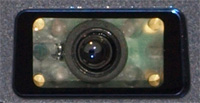 For barcode scanning, the DLI 8300 uses an integrated OPOS/JPOS-compliant (JPOS is a platform for electronic payment) Honeywell Adaptus imager. The Adaptus imager engine essentially combines a digital camera, powerful illumination and scanner aiming optics (crosshairs) in a package small enough to easily fit into compact tablets such as the 8300. If auto-range scanning is required, the 8300 can be equipped with a Motorola Lorax scanner instead. For barcode scanning, the DLI 8300 uses an integrated OPOS/JPOS-compliant (JPOS is a platform for electronic payment) Honeywell Adaptus imager. The Adaptus imager engine essentially combines a digital camera, powerful illumination and scanner aiming optics (crosshairs) in a package small enough to easily fit into compact tablets such as the 8300. If auto-range scanning is required, the 8300 can be equipped with a Motorola Lorax scanner instead.
DLI prides itself on making available a 3-in-1 module that combines a mini mag stripe reader, a 13.56MHz RFID reader, and an Adaptus imager. If mag stripe reading is not needed, there's an optional integrated 13.56 MHz RFID reader that's compatible with the ISO/IEC 14443 A/B spec for proximity cards, with ISO15693 (longer range reads) available as well. This is used for contactless payment systems.
The DLI 8300 also provides optional GPS functionality via a SiRFstarIII chipset with internal Geohelix antenna. This might come in handy for geo-tagging of transactions. And if a camera is desired, the 8300 can be ordered with a 2-megapixel autofocus digicam (the DLI 8800 does not include cameras whereas the DLI 8400 has both a front and a rear mounted camera).
Bright 8.4-inch display
Displays can make or break a mobile computer, and especially one that will be used outdoors and in bright sunlight. Outdoor use tends to expose display flaws, be it excessive glare, reflection, inadequate backlight, optical aberrations, etc. So how does the DLI 8300's display do?
Overall, it is a nice display to work with. Those who find the DLI 8800's 7-inch screen too small will feel much more at home on the 8300's 4:3 aspect ratio 8.4-inch screen with significantly more real estate. The screen's native 800 x 600 pixel resolution is still more or less standard for industrial tablets, though it's become marginal for today's high-density websites and apps. You can set the 8300 display to 1024 x 768 pixel, but it's nowhere near as sharp and crisp as the native SVGA resolution.
The surface treatment of the display is excellent. Most current consumer market computing devices, including tablets and phones, have "gloss" screens that look nice and crisp indoors, but generate horrible reflections outdoors. The 8300's display is on the matte side, but it isn't matte enough to swallow up all the light. Display viewing angles are important, too, so that users don't constantly have to reposition the device in order to see what's on the screen. Horizontally, the 8300's viewing angle is perfect; you can look at it from the side and the picture never changes. Vertically, the picture also remains visible at extreme angles, but when you turn the display up and away from you, there's a chromatic shift that changes colors.
In mid-2010, DLI introduced what they call their HiBrite LED technology. HiBrite has enhanced brightness, better contrast, a wider viewing angle, and optical treatments and polarizers reduce internal reflection (see DLI release). The result would be up to 900 nits. HiBrite displays were optional, but the switch to LED backlighting would also boost the brightness of the standard displays to over 400 nits. I believe that our review unit did not have HiBrite and was indeed in the 400 nits range, which is still quite bright (standard notebooks usually have in the 180-200 nits range).
The first picture below shows an outdoor daylight comparison between the DLI 8300 and an Apple iPad. The iPad has a superb 1024 x 768 display that is also quite bright and looks great indoors, and it even retains brightness outdoors. The DLI 8300 has a slightly smaller display, but is a visibly brighter. And another quality of the DLI display is immediately noticeable: no reflections, whereas the glossy Apple display struggles.

The second picture, shows the two devices outdoors, facing the sky on a moderately bright California winter morning. Most standard displays simply wash out outdoors as their backlights cannot compete with daylight. The iPad's backlight is strong enough to be seen, but its glossy surface makes it completely unreadable. The 8300 retains almost perfect readability without any reflections at all.

The next picture shows the two tablets from an angle. This is where reflections can be especially bothersome, and also where anti-glare treatment can make a display appear milky. Again, the DLI display is totally unaffected. The Apple display also doesn't have any anti-glare issues, but it is not as bright and there are reflections.
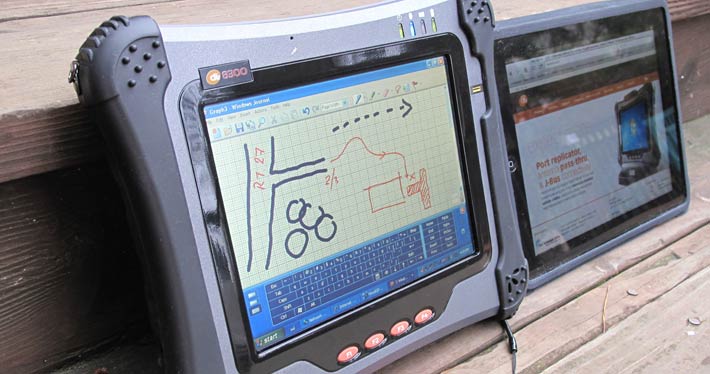
When comparing displays, it's interesting how some prefer the older 4:3 aspect ratio whereas others are drawn to the "modern" wide format 16:10 or even 16:9 aspect ratio displays. Apple actually stuck with 4:3 in the hugely successful iPad whereas most new tablets on the market use 16:10. It's definitely a matter of preference. As is, the 8300's fairly large display is bright enough, handles glare and reflections very well, and remains readable under almost any lighting condition. It does have a yellowish tint to it, though, and we'd like to see a wider vertical viewing angle.
One thing we weren't crazy about is the glossy black bezel around the display. It looks elegant, but reflects and distracts. Matte would be much better.
Digitizer
The DLI 8300 can be ordered either with a resistive touchscreen or an active digitizer. Our test unit had the resistive touchscreen, that can either be used with the supplied and tethered 4-1/2-inch orange plastic stylus or with a finger. It's configured with the PenMount Control Panel that includes three primary settings screens:
Calibrate handles touch calibration using 4, 9, 16, or 25 points, with 25 points offering the maximum accuracy. In advanced mode you can opt to show calibration data.
Setting lets you select either mouse emulation mode or click-on-touch, enable a beep sound to occur on pen down or pen up (or both), and even set its frequency and duration. I am not sure how that would be used, but in noisy vehicle operation, having auditory feedback to confirm a touch operation may come in handy. You can also engage a cursor stabilizer to eliminate cursor jitter, and you can set how the digitizer should handle right clicks.
Edge compensation determines how the digitizer acts along the perimeter of the display where it is sometimes hard to accurately control the cursor.
Below you can see the three PenMount configuration screens.

The PenMount control panel also lets you configure multiple monitors and map them for touch. You can also enable gestures and assign keys, applications or actions to a total of 15 simple gestures (see available gestures to the right).
While the DLI 8300's resistive touch panel works well (and especially so with the stylus), realize that resistive digitizer technology was designed to be used with a stylus. Touch works, but not very well. I mention that because ever since the iPad popularized projected capacitive touch, everybody expects finger touch to work on any touch screen. Also, note that resistive digitizers do not take full advantage of the many Microsoft and third party pen utilities that were all designed for use with an active inductive digitizer that is optionally available on this machine. The 8300 does come with the Microsoft Input Panel where you can enter text with the onscreen keyboard or with either a free-form or combed handwriting input window. Ink goes on very well, and there is almost none of the hesitation often seen in touchscreens that can interfere with recognition. This is good because potentially very valuable utilities such as Microsoft Journal all rely on the smooth flow of ink.
Bottom line here: while the DLI 8300's resistive digitizer works well for tapping and operating small click boxes and such, those who require ultra-smooth ink or cursor tracking (the cursor following the tip of the pen hovering above the display) should go for the active digitizer option. Ideally, a dual input panel option that supports both active pen and touch would be available as an option as well (or one that combines projected capacitive touch and electromagnetic, such as Wacom's G6 Multi-Touch).
Data entry methods: onscreen keyboards, recognition and inking
Unlike the DLI 8400 UMPC, the DLI 8300 does not have an integrated physical keyboard. You can, of course, connect an external USB keyboard to it, and that is by far the best method to type larger amounts of text into the 8300. There are, however, also two onscreen keyboards you can use to enter data. The pictures below show some of the onscreen data entry methods for 8300s running Windows XP. The gray onscreen keyboard is a DLI utility that closely mimics a standard physical keyboard. Microsoft's standard input panel that includes a comprehensive onscreen QWERTY keyboard can be toggled between modes to show standard F1-F12 function keys. The soft keyboard, however, requires the stylus and does not work well with touch (unless you use a fingernail).
The input panel also includes two versions for handwritten input, one free form, and one combed with individual boxes for each symbol (bottom). All applications work with these soft keyboards.
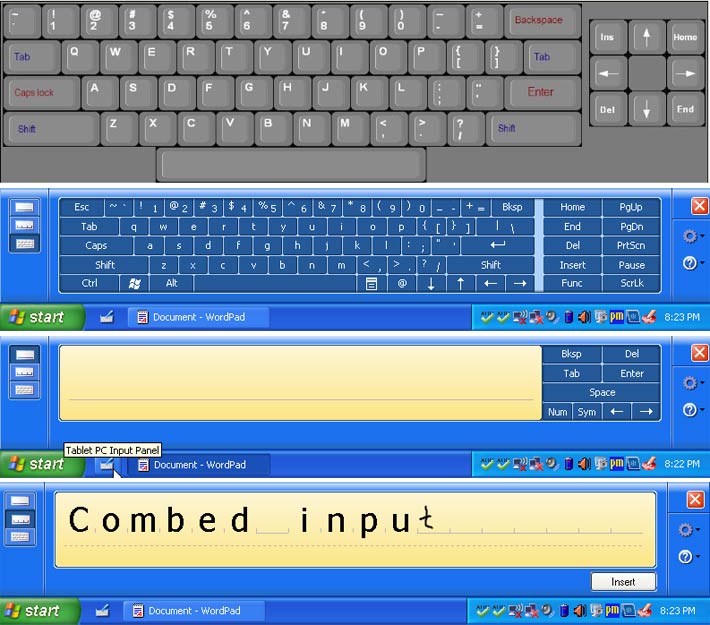
 Any device equipped with a touchscreen offers potentially very useful additional functionality that is not available on a standard computer. That includes very flexible navigation and operation via tapping, and it also includes handwriting recognition, a technology that has seen its share of negative press (mostly based on unrealistic user expectations) but actually works quite well. Any device equipped with a touchscreen offers potentially very useful additional functionality that is not available on a standard computer. That includes very flexible navigation and operation via tapping, and it also includes handwriting recognition, a technology that has seen its share of negative press (mostly based on unrealistic user expectations) but actually works quite well.
First introduced in the original Windows XP Tablet PC Edition, the Microsoft Input Panel, in a somewhat improved version, remains part of Windows 7. Using it requires some practice, but it offers good handwriting recognition support. The recognizer can be used with its defaults, but it can also be trained to learn specific styles of handwriting and how to recognize whatever characters or words the recognition engine has problems with.
In order to take full advantage of a tablet such as the DLI 8300, users will want to install some of the many freely available utilities and applications specifically developed for pen and touch input. Microsoft itself offers the free "Experience Pack for Tablet PC" for download. It includes games and demonstrations and I believe is still available for the XP Tablet PC Edition (but not for Windows 7).
The 8300 also comes with Microsoft Journal, a handy electronic inking notepad that, depending on your style of work, can be a very useful productivity tool. Journal lets you write notes in electronic ink, do drawings, convert handwritten notes to text, email your notes, and so on. There are different size and color pens, highlighters and also an eraser.
The software described represents just a few examples of handy tools available for touch and pen-based systems like the DLI 8300. There are many more, both utilities and full applications (we especially like the downloadable Snipping Tool), and they can add a lot of functionality on top of what is available in the standard operating system.
Do keep in mind that some of these utilities are optimized for touch or a stylus whereas others work best with an active digitizer. The availability of certain applications may help you decide between touchscreen or active digitizer.
Summary
DLI offers a full lineup with tablet computers for different purposes and in different sizes. All have a distinct "DLI" look and feel with the same colors and design elements, but each is different and clearly designed for a specific task. There is no real overlap. but it is still important to realize where a model fits in. The role of the 8300 is that of a general purpose tablet computer large enough to serve as a "real" computer in the field or in a vehicle, but small and portable enough to be carried around on the job.
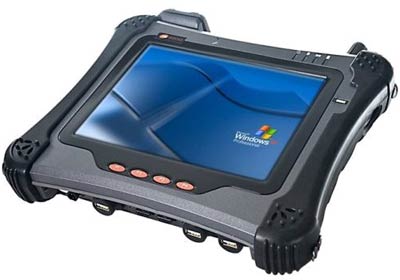 Measuring 10.25 x 9.5 x 1.85 inches and weighing a bit over four pounds with both batteries and the bumpers, the DLI 8300 has a slightly larger foot print than other rugged tablet due to its curvy design, but it weighs less than most. Its 8.4-inch touchscreen (digitizer available) with conventional 4:3 aspect ratio 800 x 600 resolution is large enough to be useful. 1024 x 768 interpolated setting is possible, but then the screen is not as sharp. Measuring 10.25 x 9.5 x 1.85 inches and weighing a bit over four pounds with both batteries and the bumpers, the DLI 8300 has a slightly larger foot print than other rugged tablet due to its curvy design, but it weighs less than most. Its 8.4-inch touchscreen (digitizer available) with conventional 4:3 aspect ratio 800 x 600 resolution is large enough to be useful. 1024 x 768 interpolated setting is possible, but then the screen is not as sharp.
In its native mode, the display is bright and very sharp, and offers good outdoor viewability without any glare. There is a slight yellow tint and the vertical viewing angle could be wider. The resistive touch screen works well and is highly configurable. Electronic ink goes on smoothly enough for drawing and handwriting recognition, though some may prefer the optional active digitizer.
Onboard connectivity is concentrated in a reconfigurable I/O board with enhanced IP65 sealing and screw-on connectors, all facing down for convenient use in vehicles. The device itself offers two USB ports and a LAN jack; additional connectivity (including up to three serial ports) is available via the compact, lockable vehicle cradle.
Like all of DLI's tablets, the 8300 can be equipped with a variety of data collection options, including a unique 3-in-1 module with an integrated magnetic card reader, an integrated barcode scanner, and an RFID reader. There's also a fingerprint reader and an optional camera.
Powered by a 1.6GHz Intel Atom Z530 processor, the DLI 8300 provides a balance between good performance and good battery life. Unique is a powerful internal backup battery that's good for a couple of hours of operation all by itself.
The DLI 8300's elegant and purposeful ABS+PC Polymer housing feels very solid and should be able to withstand most accidents and exposure to the elements in the field. IP54 sealing and the ability to survive 4-foot drops make the unit suitable for deployment almost anywhere.
With the 8300 rugged tablet computer, DLI offers a compact, well made multi-purpose tablet suitable for a very wide range of applications.
-- Conrad H. Blickenstorfer, January 2011
DLI 8300 Specs:
| Type |
Rugged Tablet
|
| Added/updated |
Added 01/2008; updated 05/2009; full review 1/2011, updated 04/2013
|
| Processor |
1.6GHz Intel Atom Z530 with 512KB L2 cache and 533MHz FSB |
| Display Chipset |
Intel "Poulsbo" System Controller Hub US15W |
| Video |
Intel Graphics Media Accelerator 500 (Intel GMA 500) with 3D graphics (integrated in US15W) |
| BIOS |
????? |
| OS |
Windows 7 Pro, Windows XP Pro Tablet Edition, Windows Embedded Standard 7, Windows Embedded Standard, Windows POSReady 2009, Windows 7 Ultimate, Linux 2.6 (Ubuntu)
|
| Memory |
2GB DDR2 SO-DIMM 533MHz |
| Display |
8.4" SVGA 800 x 600 pixel or XGA 1024 x 768 pixel indoor/outdoor readable TFT with 400 nit backlight |
| Digitizer |
Touchscreen or active digitizer (standard or polarized)/1 |
| Keyboard |
4 user programmable keys + 2 trigger keys (left and right) |
| Navigation |
Stylus, touch |
| Storage |
60/80GB shockmounted 1.8-inch HD or 8-64GB industrial SSD |
| Expansion slots |
2 PC Card Type II slots (one used for WiFi) |
| Housing |
Impact-resistant ABS+PC polymer |
| Size |
10.25 x 9.5 x 1.85 inches |
| Weight |
4.1 lbs. as tested with battery, bumpers and handstrap |
| Operating temperature |
-4° to 122°F (-20° to 50°C)
|
| Ingress protection |
IP54 |
| Drop |
Multiple 4ft to bare concrete |
| Shock |
Operating -20G, (11ms), Crash -75G (11ms)
|
| Vibration |
5~500Hz 1G PTP, MIL STD. 810F 514.5C-3 Highway truck vibration exposure |
| EMI/EMC |
FCC Class B, CE |
| Power |
Hot swappable external 14.8V 2,800mAH 38.5 watt-hour Li-Ion + internal 2,000mAH ("5-6 hrs of usage") |
| Interface |
2 USB 2.0, 1 RJ45 Gigabit LAN, 2 RF pass-through, biometric reader; optional: integrated Adaptus Imager JPOS-Compliantor Motorola Lorax auto ranging scanner, DB9 RS232, 3-in-1 module (Adaptus imager, mini magstripe, 13.56Mhz RFID reader) |
| Wireless options |
802.11b/g/n WiFi (Cisco CCX5) or optional 802.11a/b/g/n, SiRFstarIII GPS, optional Bluetooth Class 2, WWAN radios via user-accessible PC Cards incl. support for external antenna (carriers supported: Verizon, AT&T, T-Mobile)
|
| Warranty |
Standard 1 year; available no-fault service coverage |
| Price |
inquire |
| Website |
DLI 8300 page |
| Brochure |
DLI 8300 |
| Contact |
1-219-362-1759 or 800-526-1299 tollfree |
(copyright 2010 RuggedPCReview.com)
|



